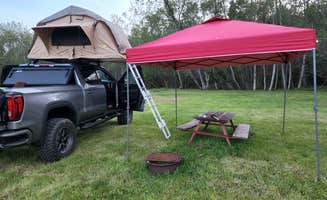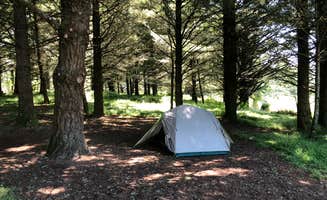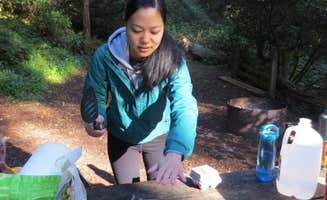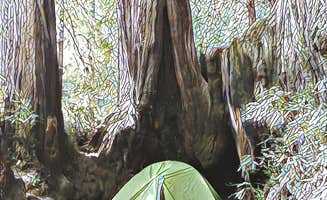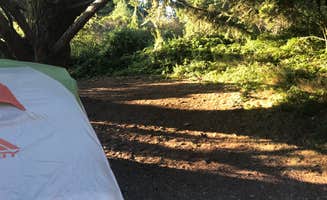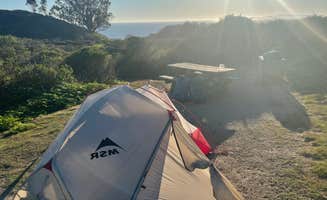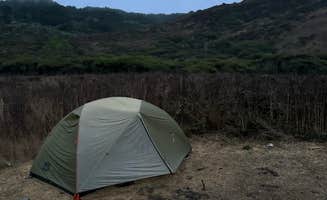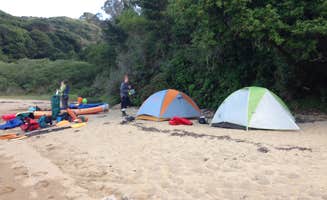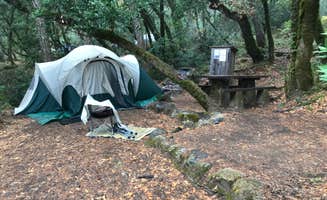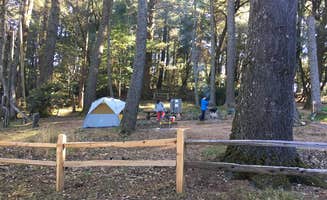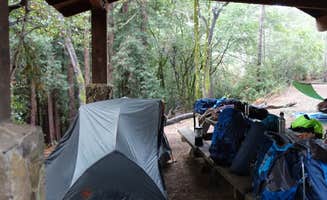Camping near Olema situates visitors within a 10-mile radius of Point Reyes National Seashore headquarters, providing access to diverse ecosystems from coastal bluffs to redwood groves. The region sits at approximately 80 feet elevation with average summer temperatures ranging from 50-65°F, creating mild camping conditions that contrast with the fog and wind often experienced at coastal sites. Winter brings significant rainfall, with December through February averaging 6-8 inches monthly.
What to do
Horseback riding in Olema: Five Brooks Ranch offers trail rides through Point Reyes National Seashore trails that connect with Wildcat Campground. "I'd recommend taking the time to go to the south end, after checking in at the station, to the trailhead called Palomarin. The trail is largely up on the bluffs above the coast, with killer views. Good place to see whales," notes a Wildcat Campground visitor.
Beach combing: The coastal areas near Dillon Beach provide excellent opportunities for finding sand dollars and other treasures. "The beach is lovely, and not overcrowded. Great for beach combing when the tide is low. We often find sand dollars," explains a visitor to Lawson's Landing.
Wildlife viewing: Point Reyes offers exceptional opportunities to see diverse wildlife. "I've seen deer in the seaside vernal pools, wild miniature ocean bunnies boxing in the morning sunshine, and a great white shark off the cliffs one fine day," reports a camper at Steep Ravine.
Hiking Mt. Tamalpais: The trails accessible from camping areas offer varied terrain and difficulty levels. "From Pantoll you have very easy access to the summit of Mt. Tamalpais, easy access Stinson Beach and the coast, plus you can even skip the long lines and shuttles to get into Muir Woods. There are literally days worth of great hiking accessible from Pantoll!"
What campers like
Privacy between sites: Several campgrounds offer secluded spots away from neighboring campers. At Glen Campground, "Site 8 was a little bit secluded and away from other sites. The site was smallish and had a fox box and picnic table. Water and vault toilet provided in the campground. Quaint and cozy overall."
Access to water features: Many campsites provide proximity to beaches, streams, or lakes. "The campground is set on an open plateau just a dozen or so feet above the beach and there isn't a lot of cover between campsites. Site 7 is a bit protected by trees and is the closest to the beach so would be my choice in the future," notes a Wildcat Camp visitor.
Nearby dining options: The proximity to small towns means easy access to restaurants when campers don't want to cook. At Olema Campground, one visitor shared, "We nestled our Sprinter between to large pine trees and took the dog for a walk. Then headed down the road for our first dinner indoors since February! It was excellent and the cocktails and desserts were excellent too. The next morning we hit the little store at Due West before our hike for coffee and pastries."
Trail accessibility: Many campgrounds serve as perfect basehubs for trail exploration. "There are all kinds of trails available, as well as a paved path that runs for at least a mile or so along the creek, that used to be the old railroad line through that area. They have informational signs all over the place providing historical or ecological information," reports a camper at Samuel P. Taylor State Park.
What you should know
Mouse and wildlife precautions: Small rodents can be an issue at some sites. At Steep Ravine Campground, "There were several brand new mouse traps provided at the entrance to my cabin. You'll need them. You'd think staying in a cabin would elevate the camping experience a bit, but frankly, this brought things down a couple notches."
Reservation difficulties: Many campgrounds in the area require advance planning. "These cabins are not only notoriously difficult to reserve -- you need to be ready to click 'reserve' on the website at no less than 5 minutes before the window opens for your dates of interest, which was 6 months ahead of time when I reserved," shares a Steep Ravine visitor.
Weather variability: The coastal climate can change dramatically. "It's typically windy in this area most afternoons from May to September. Between those months, there's always a chance of rain, so being inside the cabin with the woodburning stove does have a major advantage over the campsites," notes another Steep Ravine camper.
Traffic and road noise: Some campgrounds experience road noise despite their natural settings. At Pantoll Campground, "The campground, while nicely maintained and well-equipped is right next to a relatively busy road and during daylight hours, especially in the high-traffic times of the year, the sites themselves are very exposed to all the day visitors."
Tips for camping with families
Entertainment options: For families seeking activities beyond hiking, certain campgrounds offer additional amenities. San Francisco North-Petaluma KOA provides "Playgrounds, swimming pool, lots of space to run and scream. We stay when visiting the area and endure the screaming kids. The kids do have fun, I give them that."
Beginner-friendly options: Some sites make excellent introductions to camping for children. "For families who want a quick trip over Golden Gate Bridge to introduce their children (or adults!) to the great outdoors, their first camp, nowhere is more convenient and instantly gratifying," explains a visitor to Samuel P. Taylor State Park.
Camping etiquette challenges: Popular family sites can sometimes present challenges with noise and behavior. A Samuel P. Taylor camper notes, "You are going to probably experience some of the most ridiculous first-time campers with no sense of camping etiquette you have ever met in your life. I put up with it, for kids—- and now I have great stories."
Protected beach access: Families appreciate campgrounds with beach access but protection from coastal conditions. At Lawson's Landing, "One of the great features of this campground is that the camping area is separated from the beach/ocean by protective dunes. You can still hear the ocean, but it isn't as loud and windy as it could be. As a kid, I'd spend all day playing in the dunes."
Tips from RVers
Size limitations: Many campgrounds have restrictions on large RVs. At Samuel P. Taylor State Park Campground, a camper notes it's "a bit too tight for large trailer or RV camping (unless you are an expert at maneuvering through tight spaces)."
Street navigation challenges: The roads to some campgrounds can be difficult for larger vehicles. An RVer at San Francisco North-Petaluma KOA reported, "After looping around to approach the site, I found the streets all very tight for RV maneuvering. The place was packed. Had a pull through FHU site. Pretty narrow. Seems like a common theme."
Weather preparation: RVers should prepare for significant weather changes. "The weather is GREAT, and you can usually count on some light wind daily. It's amazing kite weather. The sites are in full-sun, so plan for shading yourself. I suggest a pop-up canopy, and double suggest staking it down," advises a camper at Lawson's Landing.
Hookup variations: RV sites offer varying levels of amenities. At Olema Campground, "We stayed in an RV Bay with Power Hookup. Clean toilets and bathrooms. The showers were hot and had decent water pressure."


